In this article:
Carpal tunnel syndrome (CTS) is one of the most common entrapment neuropathies affecting the hands caused by the compression of the median nerve within the carpal tunnel in the forearm. (1)
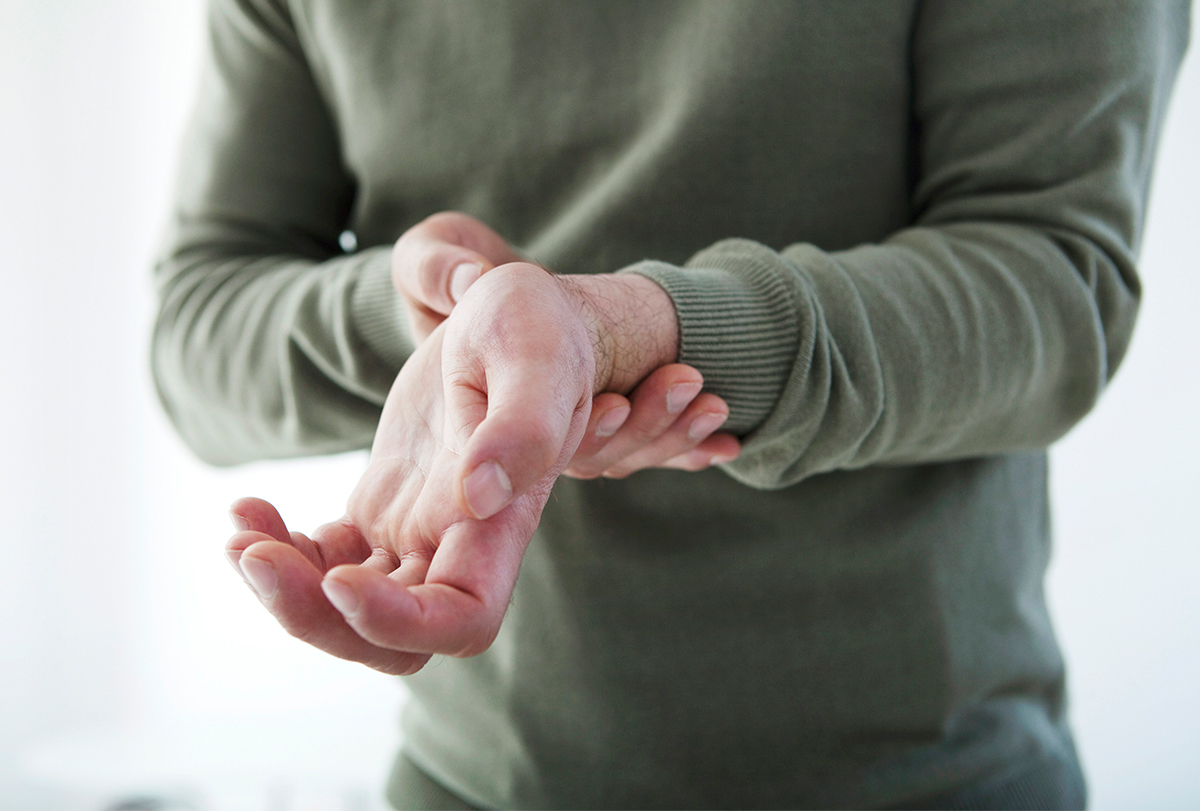
The median nerve is located on the palm side of your hand, where it passes through a narrow passageway called the carpal tunnel, and is responsible for tactile sensibility in all of the hand barring the little finger.
CTS can occur in one or both hands and is generally prevalent among women than men. This is mainly because the carpal tunnel is smaller in women than in men. (2) This condition typically develops between the ages of 30 and 60, and symptoms tend to progressively worsen with time.
Home Remedies for Carpal Tunnel Syndrome Relief
Here are a few home remedies for carpal tunnel syndrome.
1. Rest and elevate
According to the American Academy of Neurology, resting the affected hand and wrist is one of the primary treatment options that you must adopt at the first sign of trouble.
Avoid any activities that involve repetitive movements for a couple of weeks to prevent the symptoms from deteriorating. At the onset of the problem, you will repeatedly feel the need to shake off the tingling in your hand.
Try to keep the hands and wrists elevated whenever possible to relieve the discomforting sensations in your hands.
2. Wear braces or splints on the wrists
Keeping the wrist straight during sleep is very important, especially when suffering from CTS.
To that end, wearing a brace or splint at night is highly recommended by the American Academy of Orthopedic Surgeons. (3) A brace or splint will prevent the wrists from bending.
Keeping your wrist in a straight or neutral position reduces pressure on the nerve in the carpal tunnel. It may also help to wear a splint during the day when doing activities that aggravate your symptoms.
A 2015 study published in the Journal of Physical Therapy Science reports that splinting helps immobilize the wrist in a neutral position. (4)
Another study published in 2009 further extends support to the beneficial impact of wearing a hand brace or a wrist splint in alleviating the symptoms of CTS. (5)
Before you buy a splint or a hand brace, seek the advice of your doctor.
3. Use a cold compress
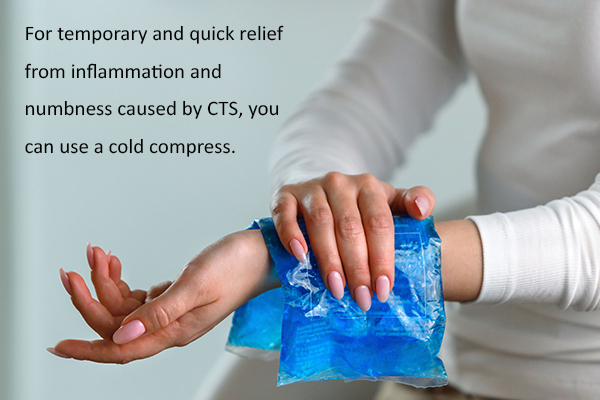
For temporary and quick relief from inflammation and numbness caused by CTS, you can use a cold compress. The cold temperature will help relieve pain by numbing the affected area. It even reduces swelling and inflammation.
A 2015 study published in the Medical Science Monitor reports that use of cold compress may help reduce compression of the carpal ligament and nerve. (6) Cold therapy is even beneficial for people who have already undergone carpal tunnel surgery. (7)
How to use:
- Put a few ice cubes in a plastic, sealable bag.
- Wrap the sealed bag in a towel and apply it on the affected area.
- Leave it in place for about 10 minutes.
- Repeat every hour or so, as needed.
Note: Never apply ice directly on your skin as it can lead to frostbite.
4. Try massage therapy
CTS symptoms can be managed by a daily regimen of massage therapy.
Massaging your hands and wrists on a daily basis activates the pressure points on your hands, which in turn increases the blood supply, relaxes stiff muscles, improves mobility, and reduces pain.
A 2013 study published in the Journal of Bodywork and Movement Therapies reports that a combination of massage and trigger-point therapy is a good treatment option for CTS. (8)
How to perform:
- Rub some warm coconut or olive oil on your hands and wrists.
- Massage your arms, wrists, hands, and fingers with gentle strokes for 10 to 15 minutes.
- Repeat this 2 or 3 times daily until you notice an improvement in your condition.
You can get help from a massage therapist as well.
Note: Do not massage if your joints feel too tender or painful.
5. Use a warm water soak
To deal with the pain associated with CTS, warm water soak is very beneficial. (9)
It improves blood circulation and relaxes sore muscles. To make the treatment more effective, you can add Epsom salt to the water. Epsom salt is a natural muscle relaxant that helps relax the tightened muscles in your hands and wrists.
How to use:
- Mix ½ to 1 cup of Epsom salt in a deep tub with warm water.
- Soak your hands and wrists in it for about 15 to 20 minutes.
- Use this remedy 2 or 3 times a week until you get relief from pain and stiffness.
6. Perform stretching exercises
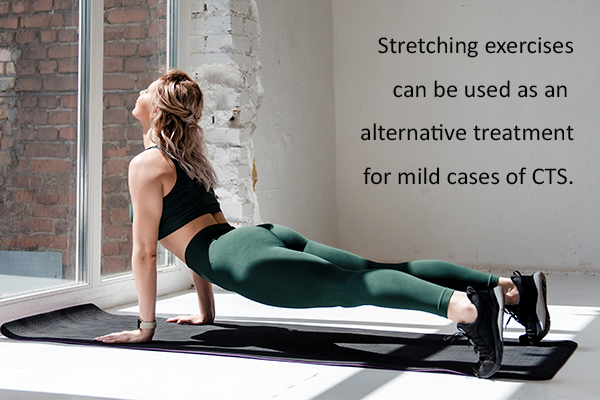
It’s good to flex, rotate, and stretch your hands, wrists, and arms several times a day when suffering from CTS. This helps increase blood circulation and may also alleviate some of the symptoms.
It has been found that such stretching exercises can be used as an alternative treatment for mild cases of CTS. (10)
Stretching exercises are easy to do and can be done while sitting at your desk or waiting in line or whenever you have a few minutes to spare.
How to perform:
- Make a fist, release your hand, and shake your fingers. Repeat 5 to 10 times.
- Put your hands in a prayer position. Spread your fingers apart and keep the tips touching the fingers of the opposite hand while you open and close your palms. Do this for 5 to 10 minutes.
- Shake your hands as if you are trying to air-dry them for 5 minutes at a time.
Ask your doctor about more stretching exercises that can increase circulation, movement, and mobility in your wrists and hands.
7. Give acupressure and acupuncture a try
Acupressure and acupuncture therapies are additional ways for the natural treatment of CTS. These methods help restore normal nerve functioning and provide relief from pain.
In fact, acupressure and acupuncture are good options for those who want to avoid early surgery. A 2012 study published in the Journal of Research in Medical Sciences corroborated the positive impact of acupuncture therapy in reducing the symptoms of CTS. (11)
How to perform:
There are specific acupressure points on your wrist and elbows (for example, pericardium 6 or PC 6) that you can press gently for a few seconds using your thumb and forefinger to promote the flow of energy and restore range of motion. Consult a skilled acupuncturist for proper treatment.
8. Apply castor oil
Castor oil is an effective ingredient for treating CTS as it can help reduce inflammation, suppress pain, and restore normal functioning in your wrists.
The ricinoleic acid (RA) of castor oil exerts analgesic and anti-inflammatory effects. (12)
- Warm some castor oil and apply it on your hands and fingers.
- Massage your wrists, thumbs, fingers, and the back of your hands for 10 to 15 minutes.
- Wrap your hands in a flannel and leave it on for an hour.
- Do this once daily for a week or until there is an improvement.
9. Use flaxseed oil
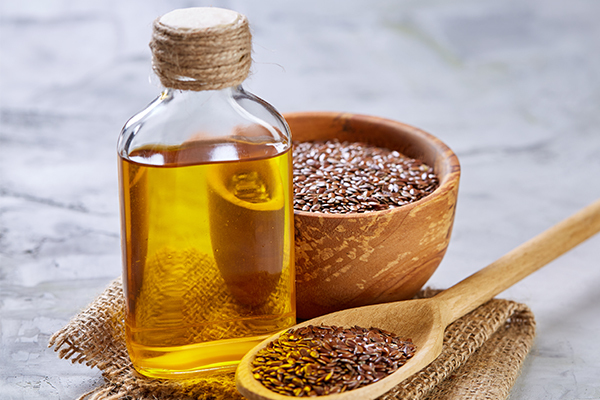
Flaxseed oil, also known as linseed oil, can help alleviate pain and swelling associated with CTS, mainly due to its analgesic, anti-inflammatory, and antioxidative effects. It is extremely rich in omega-3 fatty acids, which reduce inflammation.
A 2014 study published in DARU Journal of Pharmaceutical Sciences suggests that linseed oil is effective in the management of mild and moderate CTS. It helps improve the severity of symptoms and functional status of the affected forearm. (13)
How to consume:
- Consume 1 to 3 tablespoons of flaxseed oil daily.
- You can even add it to your smoothie, milk, or juice.
10. Incorporate vitamin B6 in your diet
Experts suggest that vitamin B6 deficiency may be one of the factors responsible for CTS. (14)
Given that vitamin B6 plays a key role in neurotransmitter synthesis and amino acid metabolism, it is essential to include more vitamin B6-rich foods in your diet.
It was even suggested in a 2007 study published in the Canadian Family Physician that vitamin B6 use is recommended as part of complementary treatments to postpone hand surgery in those suffering from CTS. (15)
How to consume:
- Some foods rich in vitamin B6 are bran, pistachios, salmon, tuna, sesame seeds, sunflower seeds, hazelnuts, raw garlic, oatmeal, wheat germ, and brown rice.
- You can also take vitamin B6 supplements, 50 to 100 mg twice daily, after consulting your doctor.
Causes of Carpal Tunnel Syndrome
Although the cause for most cases of CTS go unidentified, it is typically associated with excessive pressure on the median nerve, which travels through the wrist entrapped in the carpal tunnel and passes into the hand.
This pressure can be due to swelling in the carpal tunnel, swelling in the surrounding flexor tendon sheaths, or swelling in a nerve.
CTS can also be caused by some kind of underlying medical conditions that causes swelling in the wrist and poor blood flow. Such medical conditions include:
- Diabetes
- Thyroid dysfunction
- Fluid retention due to pregnancy or menopause
- Hypertension or high blood pressure
- Autoimmune disorders like rheumatoid arthritis
- Fractures and trauma to the wrist that cause compression of the median nerve due to the narrowing of the carpal tunnel
CTS is often aggravated by overextension of the wrists due to repeated motion. This can result from:
- Computer overuse, which calls for the positioning of the wrists in a certain way that exerts pressure on the wrists
- Prolonged use of hand tools or power tools
- Playing the piano or typing for an extended period of time, regularly
There are also certain lifestyle factors that may increase the risk for CTS. Such risk factors are:
- Smoking
- High salt intake
- Sedentary lifestyle
- Certain nutritional deficiency
- Obesity
Even people with jobs that require repetitive wrist movement are at high risk, such as construction workers or keyboarding occupations.
Signs and Symptoms of Carpal Tunnel Syndrome
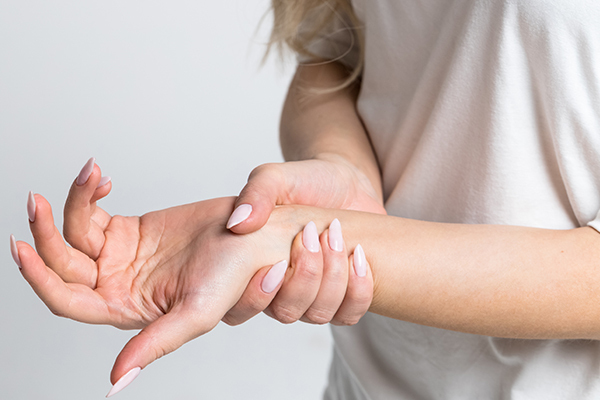
The first sign of CTS is numbness or tingling sensation in the thumb and the first three fingers of your hand, which can come and go from time to time. However, as the disease progresses to an advanced stage, it may lead to severe pain and weakness in the hands and even cause nerve damage. (16)
Other symptoms include:
- Weakness in the hands
- Poor grip
- Burning sensation that can be felt up to the arm and wrist pain (especially at night)
Preventive Measures Against Carpal Tunnel Syndrome
As there are several causes of CTS, it is difficult to prevent. However, you can take certain measures to prevent this disease.
- Do stretching exercises before and after activities.
- Try to sleep with your wrists held straight and try to keep your arms elevated while sleeping. Avoid sleeping on your hands.
- When using mechanical tools, keep your wrists straight as much as possible.
- Avoid flexing and extending your wrists repeatedly.
- Take frequent rest breaks from repetitive activities.
- Try to keep your hands and wrists warm by wearing gloves; cold contributes to the pain and stiffness associated with CTS.
- If you spend a considerable time on the computer, make sure that your keyboard is placed at elbow height or slightly lower and the mouse is comfortable enough to allow your wrists to stay in a relaxed middle position and your grip to stay at ease. When typing or using a mouse for an extended period of time, make sure to use a wrist pad.
- Use big pens with a soft grip and free-flowing ink for prolonged handwriting.
Additional Tips to Mange Carpal Tunnel Syndrome
- Eat antioxidant-rich foods like blueberries, cherries, tomatoes, squash, and bell peppers.
- Include turmeric in your diet. You can also take it in supplement form, 300 mg three times a day.
- Use healthy oils, such as olive oil for baking or frying.
- Avoid red meats. Eat more lean meats and cold-water fish.
- Quit smoking as it promotes the blockage of narrow blood vessels and worsens the symptoms.
- Stop activities that may give rise to feelings of numbness and pain.
- Do yoga exercises that are designed to stretch and strengthen the joints in the upper body.
- Improve your posture to reduce your risk of CTS.
When to See a Doctor

See your doctor if CTS signs and symptoms are interfering with your normal activities and sleep patterns.
Advanced stages of this condition may require medical attention to prevent permanent nerve and muscle damage. During the initial stage or for mild symptoms, home remedies can reduce the pain and other discomforts and help restore wrist and hand function.
Final Word
The above listed remedies and measures are mostly useful during the initial stage of carpel syndrome when the symptoms are mild. They can help relieve the pain and other discomforts associated with this condition to help restore wrist and hand function.
But advanced stages of this condition may require medical attention to prevent permanent nerve and muscle damage.
- Was this article helpful?
- YES, THANKS!NOT REALLY


